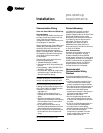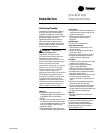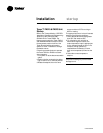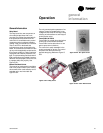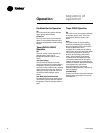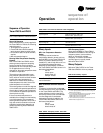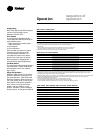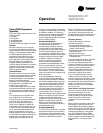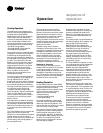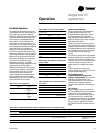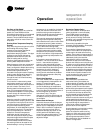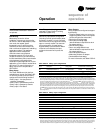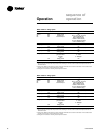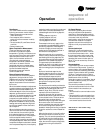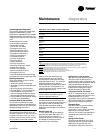
54 UNT-SVX07A-EN
Operation
sequence of
operation
Cooling Operation
The heating and cooling setpoint high
and low limits are always applied to the
occupied and occupied standby
setpoints. During the cooling mode, the
Tracer
ZN520 controller attempts to
maintain the space temperature at the
active cooling setpoint. Based on the
controller’s occupancy mode, the active
cooling setpoint is one of the following:
• Occupied cooling setpoint
• Occupied standby cooling setpoint
• Unoccupied cooling setpoint
The controller uses the measured space
temperature, the active cooling setpoint,
and discharge air temperature along
with the control algorithm to determine
the requested cooling capacity of the unit
(0-100%). The outputs are controlled
based on the unit configuration and the
required cooling capacity. To maintain
space temperature control, the Tracer
ZN520 cooling outputs (modulating
hydronic valve, two-position hydronic
valve, or outdoor air economizer
damper) are controlled based on the
cooling capacity output.
The cooling output is controlled based on
the cooling capacity. At 0% capacity, all
cooling capacities are off and the
damper is at minimum position. Between
0 and 100% capacity, the cooling outputs
are controlled according to modulating
valve logic (modulating valves) or cycled
on (2-position valves). As the load
increases, modulating outputs open
further and binary outputs are energized
longer. At 100% capacity, the cooling
valve or damper is fully open (modulat-
ing valves) or on continuously (and 2-
position valves).
Unit diagnostics can affect fan operation,
causing occupied and occupied standby
fan operation to be defined as abnormal.
Refer to the Troubleshooting section for
more information about abnormal fan
operation.
The Tracer
ZN520 controller operates the
supply fan continuously when the
controller is in the occupied and occupied
standby modes, for either heating or
cooling. The controller only cycles the fan
off with heating and cooling capacity in
the unoccupied mode.
The economizer is used for cooling
purposes whenever the outdoor tem-
perature is below the economizer enable
setpoint and there is a need for cooling.
The economizer is used first to meet the
space demand, and other forms of
cooling are used if the economizer cannot
meet the demand alone. See modulating
outdoor air damper operation for
additional information.
Cascade cooling control initiates a
discharge air tempering function if the
discharge air temperature falls below the
discharge air temperature control low
limit, all cooling capacity is at minimum,
and the discharge control loop deter-
mines a need to raise the discharge air
temperature. The controller then pro-
vides heating capacity to raise the
discharge air temperature to its low limit.
Discharge Air Tempering
The discharge air tempering function
enables when cold outdoor air is brought
in through the outdoor air damper,
causing the discharge air to fall below the
discharge air temperature control low
limit. The controller exits the discharge air
tempering function when heat capacity
has been at 0% for five minutes.
Heating Operation
During heating mode, the Tracer
ZN520
controller attempts to maintain the space
temperature at the active heating
setpoint. Based on the occupancy mode
of the controller, the active heating
setpoint is one of the following:
• Occupied heating
• Occupied standby heating
• Unoccupied heating
During dehumidification in the heating
mode, the controller adjusts the heating
setpoint up to the cooling setpoint. This
reduces the relative humidity in the space
with a minimum of energy usage.
The controller uses the measured space
temperature, the active heating setpoint,
and discharge air temperature, along
with the control algorithm, to determine
the requested heating capacity of the unit
(0-100%). The outputs are controlled
based on the unit configuration and the
required heating capacity.
Unit diagnostics can affect the Tracer
ZN520 controller operation, causing unit
operation to be defined as abnormal.
Refer to the Troubleshooting section for
more information about abnormal unit
operation.
The heating output is controlled based on
the heating capacity. At 0% capacity, the
heating output is off continuously.
Between 0 and 100% capacity, the
heating output is controlled according to
modulating valve logic (modulating
valves) or cycled on (two-position
valves). As the load increases, modulat-
ing outputs open further and binary
outputs are energized longer. At 100%
capacity, the heating valve is fully open
(modulating valves) or on continuously
(two-position valves).
The Tracer
ZN520 fan output(s) normally
run continuously during the occupied and
occupied standby modes, but cycle
between high and off speeds with
heating/cooling during the unoccupied
mode. When in the occupied mode or
occupied standby mode and the fan
speed is set at the high, medium, or low
position, the fan runs continuously at the
selected speed. Refer to the Trouble-
shooting section for more information on
abnormal fan operation.
When the unit’s supply fan is set to auto,
the controller’s configuration determines
the fan speed when in the occupied mode
or occupied standby mode. The fan runs
continuously at the configured heating
fan speed or cooling fan speed. For all fan
speed selections except off, the fan
cycles off during unoccupied mode.
The economizer outdoor air damper is
never used as a source of heating.
Instead, the economizer damper (when
present) is only used for ventilation;
therefore, the damper is at the occupied
minimum position in the occupied mode.
The damper control is primarily associ-
ated with occupied fan operation.



